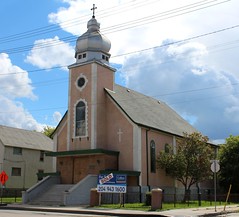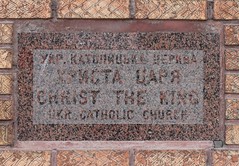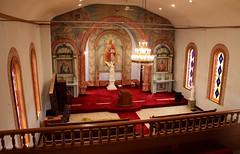Address: 376 Logan Avenue
Architect: J. A. Mattson
Opened: 1901
Zion Swedish Lutheran Church
Original Swedish Lutheran Church ca. 1899 (source)
The Swedish Lutheran Church was established in Winnipeg on October 4, 1890 by the visiting Reverend Louis G. Almen of New London, Minnesota. The congregation of around 40 people created a small church on Henry Avenue between Laura and Ellen Streets. The first regular pastor was Svante Udden who was appointed in August 1891 and served for six years.
A schoolroom was added to the site in November 1893. It was used both for Sunday school and to teach English to adult immigrants.
The following year, the congregation numbered 50 but saw as many as 200 people at their Sunday services. The church was torn down to make way for a larger, $1,000 structure on the same site. It opened on the evening of Saturday, January 26, 1895.
A tenant of the church in the late 1890s was the Winnipeg Free Kindergarten Association. Earlier in the decade they created the city's first kindergarten on Ellen Street at Logan Avenue. When they outgrew the space, they relocated to the church until 1901.
Top: Church ca. 1901 (source)
Bottom: March 19, 1901, Winnipeg Tribune
By 1900, Zion Swedish Lutheran Church's congregation had grown to more than 200 and a larger building were needed. They found a site just a block away at Logan Avenue and Fountain Street.
The old church building was moved there and in March 1901 a $4,500 building permit was issued for the expansion of the building, the addition of a brick façade, and the construction of a parsonage. The new pastor, Rev. J. A. Mattson, is credited as the architect.
May 16, 1903, Winnipeg Free Press
The church became a hub for Winnipeg’s Scandinavian community. Aside from religious services and Sunday school, it was used for meetings, political events, social activities, and cultural performances.
Rev. Mattson’s wife gave a glimpse inside the life of the church in an interview with the Winnipeg Free Press of May 16, 1903. Mrs. Mattson was born in Sweden and came to Moline, Illinois with her family when she was a child. She soon became a teacher at the Swedish Lutheran Sunday school there.
She understood the plight of the newcomers, especially young women. “A Swedish pastor’s wife is supposed to entertain all visiting Swedish people and to look after all the Swedish girls who come to the city without friends or a home….” On top of this responsibility, Mrs. Mattson had three children to raise.
Mrs. Mattson was also the president of the church's Women's Aid Society. They hosted annual craft sales that raised much needed money for church operations. Their teas and lunches were important social gatherings for the women of the small community right through to World War II.
November 1, 1930, Winnipeg Tribune
By the time Zion Swedish Lutheran Church celebrated its 25th anniversary in 1915, the congregation was more than 500 strong. In 1930, its 40th anniversary, Winnipeg's Swedish population numbered 5,000 and a week-long celebration was held at the church.
The anniversary was bittersweet as it also marked the start of the church's demise.
The heyday of Swedish immigration was over and the local population was increasingly made up of second and third generation Swedes. As they assimilated, English became their language of choice, (the church began offering English services in 1927), and they moved further away from the CPR tracks. Attendance at the church began to trail off.
May 22, 1948, Winnipeg Free Press
In 1948, the Home Mission Board of the Lutheran Church, which financially supported Zion's operations, put it on notice that their support would continue only if they changed their name, (dropping "Swedish"), and relocated to a more residential area.
The church was put up for sale in May 1948 and it was lucky that there was a building left to sell.
December 3, 1948, Winnipeg Free Press
Rev. Floyd Johnson and his wife came from Kiron, Iowa on the evening of December 2, 1948 to take over the church. They arrived to an unexpected welcome: fireman battling a fire at the church. It was contained to one corner of the basement and did $1,200 in damage. The church was back in action in time for Christmas services.
The final service as Zion Swedish Lutheran Church took place on January 1, 1950. The new church, St. Mark's Evangelical Lutheran Church, operated from the University of Manitoba's St. John's College from 1950 - 1953 before opening at Cambridge Street and Corydon Avenue.
Top: March 5, 1928, Winnipeg Tribune
Bottom: July 17, 1935, Winnipeg Tribune
Zion Swedish Lutheran was the site of thousands of ceremonies over the decades..
On March 3, 1928, hundreds of mourners showed up to mourn the death of Mrs. Lottie Adams, (nee Sundin.) The young housewife went missing from North Drive in St. Vital in mid-February. Her body was found ten days later in a snow-filled ditch, shot and chopped with an axe.
Reverend Bertil Erling, who presided over many weddings at the church, tied the knot himself there in 1935.
Rev. Gustav Grahn
More than a dozen men presided over Zion Swedish Lutheran Church, (see the list below.) The most interesting of the bunch appears to be Gustav Grahn from 1937 - 1938.
Grahn was born in a remote village in northern Sweden and at an early age developed a sense of adventure and desire to travel. He came to the U.S. as a young man and became an ordained minister. Prior to his posting at Winnipeg, he was the pastor at St. Paul's Lutheran Church in Minneapolis.
Grahn was perhaps better known for his side-gig as a filmmaker. He traveled the world for months at a time to remote parts of Europe, Africa, and North America. He edited the footage into movies and lectured with them on the Chautauqua circuit.
Just prior to his arrival in Winnipeg, Grahn spent months in East Africa and did a coast-to-coast tour of Canada's wilderness. While here, he took a three month extended vacation to travel Palestine. (For more of his movie programs.)
Zion Swedish Lutheran Church Clergy
Louis G. Almen of New London, MN (1890)
Svante Udden (1892 - 98)
E. Rehner (1899 - 90)
J. A. Mattson (1901 - 03)
Augustus G. Olson (1903 - 05)
A J Ryden of Texas (1906 - 07)
Augustus G. Oleson of Teulon (previous pastor) (1907)
J. G. Dahlberg (1907 - 14)
Victor J. Tengwald (1914 - 20)
Carl A. Anderson (1922 - 25)
Hjalmar Oleson (1927 - 28)
Rev. Arvid Vickman (1930 - 33)
Gustav Grahn (1937 - 38)
C. E. Hoffsten ( 1940 - 48)
Floyd Johnson (1949)
Christ the King Ukrainian Catholic Church
December 29, 1949, Winnipeg Free Press
In 1949 The church was purchased by the Ukrainian Catholic Church in 1949.
On December 28, 1949, Archbishop Basil Ladyka, head of Canada’s Ukrainian Catholic Church, blessed the building as Christ the King Ukrainian Catholic Church. The first service was a Ukrainian Christmas celebration on January 7, 1950.
Christ the King was a small congregation and one of ten Ukrainian Catholic churches in the city.
The first permanent parish priest, Father Michael Romanchuk, arrived in July 1950. He was born in Western Ukraine and ordained in Stanislaw in 1936. After facing hardship and persecution during World War II, he fled his homeland and arrived in Canada in 1947.
Romanchuk was vocal in the condemnation of gambling and other vices that were taking place in the neighbourhood around the CPR tracks. He was also an outspoken critic of communism.
On the night of April 12th 1952, there was a knock at the rectory door. Two men entered and began yelling profanities at the 41-year-old Romanchuk. He asked the en to leave but they instead beat him unconscious. The men then broke some windows and left. He later told the Free Press that he thought one of the men had used brass knuckles and that: "I think someone is trying to shut me up."
Romanchuk was soon off to rural Manitoba, where he served as a priest in Sarta, Neepawa, Pine River, and Gimli. In 1966, ill health caused paralysis in his legs and in 1976 he moved into the Holy Family Nursing Home on Aberdeen Avenue where he acted as the resident pastor until his death on October 10, 1981 at the age of 71.
Rev. Zachary Zoloty took over the parish and served for 18 years, from 1952 until his death in 1971.
Like Romanchuk, he was born in Western Ukraine and ordained in Stanislaw in 1923. He fled his homeland during World War II and worked in displaced person camps in parts of Europe. In 1949, he came to Canada, first to the Rosa district then Neepawa. He was also president of the board of governors for the city's private Ukrainian Schools in the 1960s.
Interior ca. 1990s (source)
In the 1970s, Rev. Antin Pakosz became the parish priest. The last priest appears to have been Rev. Bohdan Borowec in the 2000s.
The church lasted long enough to celebrate its 60th anniversary in 2010 and mass was celebrated there as late as the fall of 2011. The following year, the property was sold off.
Christ the King Ukrainian Catholic Church Clergy:
Michael Romanchuk (1951 - 52)
Antin Pakosz (1970s)
The Valiant Theatre
In 2014, the building was put up for sale again and purchased by Kelly Hughes of Aqua Books fame.
In May 2016 he announced that it will reopen as a performing venue called The Valiant Theatre.
Related
376 Logan Avenue Historic Buildings Committee
St. Mark's Lutheran Church history
My photo album of 376 Logan Avenue
The Swedes Multicultural Canada



















No comments:
Post a Comment